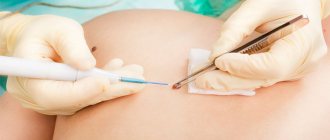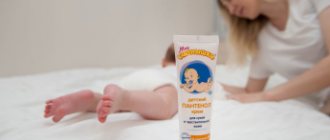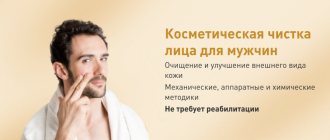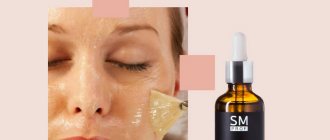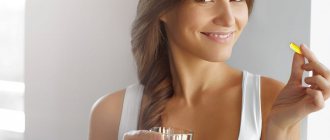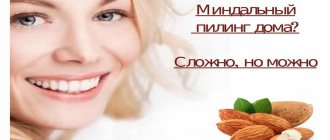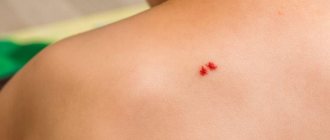Beautiful skin is first and foremost healthy skin. In order for your face to shine, you need proper nutrition, care and immunity support, incl. local, at the proper level. If acne appears on the face, especially in adulthood, the immune system cannot cope, it needs support. One of the most effective means is autohemotherapy. These are injections of the patient’s own blood, which help activate metabolic processes, strengthen the immune system and reduce inflammation.
How does the procedure work?
Previously, cosmetologists did subcutaneous injections. This made it possible to achieve the desired result, but there was a side effect in the form of hematomas. Injections began to be given intramuscularly. After them, no traces remain on the face, and the effect remains.
The procedure goes like this: blood is taken from a vein from the patient and injected into the muscles, usually the buttocks, on the opposite side. So, if blood was taken from the right arm, then an intramuscular injection is made to the left side. The course starts with 2 ml. and continue increasing with a factor of 2. The procedure is carried out every other day for 10 days, sometimes more.
Autohemotherapy
What is autohemotherapy?
Autohemotherapy is a natural treatment method known since ancient times.
In this method, blood is drawn from the patient's vein, which is then injected into the muscle. This method is used mainly to provide a stimulating effect on the patient’s body, and in particular helps to increase immunity. The body reacts to the introduction of blood as to the penetration of a foreign substance, therefore its protective functions are activated. The reaction of the body's immune system is partly due to the presence of proteins in the injected blood, which affect the process of production of protective cells. These cells quickly recognize blood as “their own”, non-dangerous, therefore all their action is directed against the pathogens present in the body. The effectiveness of this method can be assessed based on the fact that after its use the number of leukocytes (white blood cells) in the blood increases. And this is a sign of a healthy immune system. Autohemotherapy is successfully used to treat allergic, inflammatory, and infectious diseases. Of course, it is not able to influence the degenerative processes that have occurred in the body. Scheme for carrying out autohemotherapy
Not for the first time, there has been a method for carrying out autohemotherapy, the scheme of which is quite simple. The essence of the classic procedure is that a couple of ml of blood is taken with a sterile syringe and injected intramuscularly, then this dose is doubled every 2-3 days. The course takes on average 12-15 sessions and for the last of them the injected volume of blood is 10 ml. In addition to the classical method, there is a method of stepwise autohemotherapy, which differs in that the blood is prepared by shaking and adding homeopathic medicines. Her course takes about 7-10 sessions.
Indications for autohemotherapy
- Allergy.
- Age-related ailments.
- Sleep disorders.
- Depression.
- Loss of appetite.
- Chronic pain.
- Menopausal disorders.
- Improved overall well-being.
- Reducing the dose of medications taken.
- Infection, hypothermia.
How is autohemotherapy performed?
A needle is inserted into a vein and 2-5 ml of blood (less than a teaspoon) is drawn into a syringe. The blood is mixed with sodium citrate, so that it does not clot, with hydrogen peroxide and a solution of table salt. If the blood was taken from a vein in the right arm, then it is injected into the left buttock and vice versa. The blood is injected very slowly so that the patient does not experience pain. During the procedure, the patient needs to relax - this will significantly reduce the pain.
Who performs autohemotherapy?
Carrying out autohemotherapy requires certain professional knowledge. To ensure that the procedure does not cause harm or cause serious complications, sterility and professionalism are necessary. Therefore, a doctor must carry out autohemotherapy. In addition, experience and medical knowledge are required in order to assess the need for this method and ensure patient safety.
Autohemotherapy is not a widely used treatment method. It can give good results, but traditional medicine does not support this method of treatment, and comparative clinical studies have not been conducted.
In what cases is autohemotherapy used?
Autohemotherapy has a stimulating effect on the body, so this method is recommended for diseases caused by weakened immunity. Autohemotherapy is used especially successfully in geriatrics, in the treatment of senile diseases and changes associated with age. Autohemotherapy helps enrich cells with oxygen and improves the elasticity of blood vessels. In addition, the level of cholesterol in the blood decreases. Indications for autohemotherapy are sluggish protracted diseases (chronic pneumonia, furunculosis), viral diseases, narrowing of the blood vessels of the lower extremities.
Autohemotherapy for acne
In this branch of cosmetology, autohemotherapy is used most often. To cure problem skin, you need to achieve stimulation of the immune response, which is provided by autohemotherapy for acne. It is very easy to get rid of such skin problems by activating the immune system to foreign substances. Injecting the patient's own blood produces antibodies, which results in stimulation of the immune response. But this type of treatment for rashes does not always give a 100% result; sometimes, for the desired effect, this type of therapy must be combined with other treatment methods.
Autohemotherapy with ozone
To eliminate acne in cosmetology, autohemotherapy with ozone is often used.
It can be small or large: Minor autohemotherapy with ozone
In minor autohemotherapy, the classical method is used in combination with ozonation.
Fresh blood from the patient in the required volume is mixed in a syringe with an ozone-oxygen substance and injected subcutaneously or intramuscularly. This method, in addition to cosmetology, is used in urology and gynecology to stimulate the immune system, strengthening which helps cure various infectious and chronic diseases. Also in this industry, this type of therapy is used to treat sexually transmitted diseases. The autohemotherapy procedure, in addition to everything, helps in the fight against chronic fatigue, frequent overwork and lack of sleep, while increasing the patient’s vitality and performance. Major autohemotherapy with ozone
Major autohemotherapy with ozone is used for medicinal purposes due to the antibacterial, antiviral, anti-inflammatory immunomodulatory properties of ozone.
Today, there are many methods for administering therapeutic doses of ozone: intravenous, intramuscular, intra-articular and subcutaneous. Correctly calculated doses of ozone improve work processes in organs and tissues. Major autohemotherapy is a very painstaking procedure. It consists in taking blood from a vein in a volume of 50-150 ml. After this, it is placed in a special container with substances that inhibit blood clotting processes and mixed with an ozone-oxygen gas mixture. After 10 minutes, which are intended for thoroughly mixing the contents of the container, blood is administered to the patient intravenously. The amount of ozone is calculated for each patient strictly individually. Autohemotherapy with an antibiotic
Blood transfusion with an admixture of antibiotics increases the effectiveness of treatment, but this autohemotherapy is carried out with an antibiotic, which can only be prescribed by a doctor, after proper tests and a specialized examination.
This method will give more positive results in combination with procedures that help cleanse the skin: vitamin and cleansing masks.
This type of autohemotherapy is most effective if the cause of skin problems is some kind of infection. The antibiotic itself is selected by dermatologists based on the cause of the outbreak of the disease. You can find out how to do autohemotherapy at any cosmetology center that provides this service. Basically, this procedure is rarely any different from the classical method. A small amount of blood (2-5 ml) is drawn into the injection syringe. After this, it is mixed with drugs that have anticoagulating properties: sodium citrate, hydrogen peroxide or salt.
When carrying out autohemotherapy, it is worth observing the principle of eight. Its essence lies in the fact that blood from the arm is injected into the opposite buttock: from the right arm into the left muscle, from the left into the right. To protect the patient from pain, blood is injected slowly.
For each person, the treatment regimen is selected individually, but often the course of treatment lasts about 15 sessions, during which the patient’s task is to relax as much as possible to prevent pain.
Hay fever treatment
Another area of application of autohemotherapy is various allergic diseases, for example, bronchial asthma. It is known that the cause of allergies is an active reaction of the body’s immune system, so mild immunostimulation with one’s own blood is completely justified and advisable. A necessary condition is knowledge of the allergen that caused the reaction. Blood taken from a vein is mixed with a small amount of the allergen before being injected into the buttock. Treatment of hay fever with this method must be carried out in winter, before the start of the flowering season.
Autohemotherapy
successfully used in the treatment of certain mental and psychovegetative disorders.
Blood processing
Before being reinjected, the blood is subjected to ultraviolet treatment and hydrogen peroxide, a solution of table salt or allergens are added to it. However, blood that has not been treated with ultraviolet radiation can also be administered.
Contraindications and side effects for autohemotherapy
It is worth knowing about the possible dangers that autohemotherapy poses.
Contraindications and side effects are extremely minor, but they exist. Contraindications:
- development of acute myocardial infarction;
- the presence of various mental disorders;
- severe forms of arrhythmia;
- cancer;
- pregnancy;
- breastfeeding period;
- concurrent use of antibiotics;
- menopause;
- postmenopause;
- types of herpes;
- chronic inflammation of the appendages;
- papillomas.
The side effects of autohemotherapy include the fact that the blood has a rather complex structure.
It is this feature that is the reason for its rather slow absorption in the thickness of the muscles. After injections, lumps may appear at the skin puncture sites, which are painful when pressed. Over the course of several days, these sensations may increase. Therefore, to eliminate this side effect, you can use semi-alcohol compresses, an iodine mesh, or use a folk remedy: apply a cabbage leaf smeared with honey at night. These methods promote accelerated resorption of the subcutaneous infiltrate.
If you do not adhere to a fixed volume, but introduce a larger amount of blood, this may cause fever due to the development of a local inflammatory reaction.
Types of autohemotherapy
Fresh, unpurified blood is most often injected into the muscles, but this is not always the case. In some cases, various drugs are added to the plasma and injected into reflexogenic points or back into the vein. Types of autohemotherapy:
- Introduction of autologous blood. The molecular composition of plasma can be changed by exposure to X-ray waves, ultrasound, or freezing.
- Biopuncture. Blood mixed with oxygen, which enters it as a result of shaking, is injected into reflexogenic points. Sometimes homeopathic medicines are added to the composition.
- Ozone cleaning. To enhance the immunomodulatory, anti-inflammatory and antiviral effect, plasma is ozonated. This composition is injected into a vein, and not into the muscles.
- Stepwise technique. If the problem is infectious, antibiotics are added to the plasma.
Indications for treatment with autohemotherapy
The introduction of untreated venous blood strengthens the immune system and suppresses inflammation. The procedure is indicated for the following pathologies:
dermatological diseases: eczema, acne, furunculosis, pustular skin lesions; prolonged pneumonia; Chronical bronchitis; frequent colds; digestive tract disorders; immunodeficiencies; exacerbation of viral infections (papillomavirus, cytomegalovirus, herpes virus); infectious lesions of the urinary organs; trophic non-healing ulcers; damage to joints by pathogenic microorganisms; frequent nosebleeds; complicated course of menopause; gynecological diseases; adhesions in the pelvic cavity; infertility; bronchial asthma, allergic origin.
Autohemotherapy is used to accelerate metabolic processes in the body. The procedure slows down the aging process. It is also used to provoke indolent infections.
Contraindications to the procedure
There are few absolute contraindications, but there are certain restrictions. Autohemotherapy will have to be postponed during pregnancy and lactation, with a low level of hemoglobin, with a viral infection, menstruation, during menopause, inflammatory processes of the appendages, etc. The procedure is not recommended for severe forms of arrhythmia, the presence of neoplasms (malignant and benign). The final decision on the possibility of using the method in a particular case is made by the doctor.
What does autohemotherapy treat?
There are a number of diseases for which the use of this method has shown the best results.
- Allows you to get rid of purulent processes in soft tissues, including diabetic wounds;
- Chronic inflammation of the respiratory system;
- Skin diseases (psoriasis, furunculosis, acne);
- Joint diseases;
- Sluggish and recurrent gynecological diseases;
- Immunodeficiency diseases, including all colds;
- Herpetic infections;
- Cytomegalovirus infection;
- Menopausal syndrome;
- Recurrent condylomas and papillomas.
REFERENCE. If, after testing, the patient is found to have a low hemoglobin level, autohemotherapy is postponed until the condition normalizes.
Contraindications
Blood should not be injected into tissues in large volumes. This leads to a pronounced local inflammatory reaction and the formation of abscesses. The use of this technique is prohibited for the following pathologies:
malignant tumors; active phase of tuberculosis; viral hepatitis; liver damage of various origins; decompensated diseases of the kidneys and cardiovascular system; mental disorders in the acute phase; heart attack in the acute stage; pregnancy; breastfeeding period;
The procedure is not performed on persons under the age of eighteen.
Autohemotherapy price
The cost of the procedure varies depending on where exactly it will be performed. Thus, in modern Moscow medical centers the price can reach 28 thousand rubles for a course of autohemotherapy consisting of 10 procedures. Far from the capital of Russia, in “simpler” institutions, the cost of a course of treatment can reach 6-7 thousand rubles. A single injection of your own blood costs from 400 to 1000 rubles per injection.
Author of the article:
Shutov Maxim Evgenievich |
Hematologist Education: Graduated from Kursk State Medical University in 2013 and received a diploma in General Medicine. After 2 years, he completed his residency in the specialty “Oncology”. In 2016, she completed postgraduate studies at the National Medical and Surgical Center named after N. I. Pirogov. Our authors
Advantages and disadvantages of autohemotherapy
Any medical and cosmetic procedure has its pros and cons. Autohemotherapy was no exception. One of the advantages of this type of blood transfusion is that the body’s protective functions are increased. This means that its ability to resist infections increases. In addition, the body begins to independently fight existing diseases, even if they have become chronic. If a person undergoes a course of treatment, then it gives a much better result.
As for the negative aspects, autohemotherapy causes the formation of compactions on the buttocks. They appear after about the fifth procedure. Such seals cause pain, especially when sitting. In addition, this type of transfusion has not been fully studied. Therefore, no doctor guarantees a 100% result. However, doctors still recommend autohemotherapy as a treatment for the above diseases.
Features and scheme of autohemotherapy
In autohemotherapy, blood is first taken from a vein. It is then injected into human tissue. When large volumes of blood are administered at once, inflammatory reactions develop. They are manifested by increased body temperature, chills and muscle pain.
Therefore, the introduction of untreated blood should be carried out according to a special scheme so that adverse reactions do not occur. During the first procedure, no more than one milliliter of the patient’s own blood is injected under the skin. Gradually its volume is increased, bringing it to ten milliliters. Then they gradually begin to reduce this amount.
Further treatment is carried out as follows:
- No more than two milliliters of blood is injected into the gluteal muscle. They are taken from the patient’s vein directly during the procedure. The injection is carried out in the upper outer quadrant of the gluteal region.
- Repeat the procedure two days later. In this case, the blood volume is increased to four milliliters.
- The third injection is given two days later. The volume of injected blood reaches six milliliters.
- Then the procedure is also performed at intervals of one or two days. At the fourth injection, 8 ml is injected, the fifth - 10 ml, the sixth - 10 ml of fresh blood.
- During the seventh injection, 8 ml of blood is injected. Then therapy is continued according to a reducing regimen.
When performing the procedure, observe sterile conditions. The course of treatment is up to fifteen procedures. Ingoda autohemotherapy is combined with ozonation of venous blood and its exposure to x-rays. It is often carried out in conjunction with hirudotherapy.
